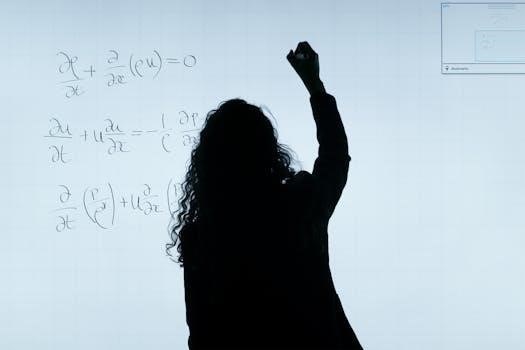Transitioning to advanced mathematics signifies a pivotal shift from computational methods to rigorous proof-based reasoning. This transition often requires dedicated courses using texts like “Mathematical Proofs” or “A Transition to Advanced Mathematics,” which bridge the gap between calculus and more abstract mathematical concepts.
The Need for Transition Courses
The increasing number of students entering universities with calculus backgrounds, often acquired in high school, masks a critical deficiency⁚ a lack of foundational understanding in rigorous mathematical thinking. Many students are proficient in applying calculus techniques but struggle with constructing proofs and understanding abstract concepts. This disparity highlights the urgent need for transition courses. These courses serve as a vital bridge, connecting the computational focus of introductory calculus to the proof-oriented nature of advanced mathematics. Without such a bridge, students may find themselves unprepared for the demands of upper-level mathematics courses, such as abstract algebra, real analysis, and topology. Transition courses provide the necessary tools and techniques for understanding and constructing mathematical proofs, mastering set theory fundamentals, and developing the ability to think abstractly. They instill a deeper appreciation for the theoretical underpinnings of mathematics, fostering critical thinking and problem-solving skills essential for success in advanced studies. Moreover, transition courses address the shift in emphasis from rote memorization to conceptual understanding, empowering students to engage with mathematics at a more profound level. The goal is not merely to perform calculations but to comprehend the underlying logic and reasoning that drive mathematical results.

Textbook Overviews
Several textbooks are designed to facilitate the transition to advanced mathematics. These books, such as “Mathematical Proofs” by Chartrand, Polimeni, and Zhang, and “A Transition to Advanced Mathematics” by Smith, Eggen, and St. Andre, offer distinct approaches to the subject.
“Mathematical Proofs⁚ A Transition to Advanced Mathematics” by Chartrand, Polimeni, and Zhang
“Mathematical Proofs⁚ A Transition to Advanced Mathematics,” authored by Gary Chartrand, Albert D. Polimeni, and Ping Zhang, is a widely used textbook aimed at bridging the gap between lower-level mathematics and more advanced, proof-oriented courses. The book is structured to guide students through the fundamental concepts and techniques necessary for constructing rigorous mathematical proofs.
The fourth edition of this textbook covers a broad range of topics, including logic, set theory, relations, functions, and different proof methods such as direct proof, contrapositive proof, proof by contradiction, and mathematical induction. The authors emphasize clarity and precision in mathematical writing and encourage students to develop their problem-solving skills through numerous examples and exercises.
The book’s approach is designed to ease students into the world of abstract mathematics, providing them with a solid foundation for further study in areas such as real analysis, abstract algebra, and topology. It is suitable for undergraduate students making the transition from calculus-based courses to more theoretical mathematics. The book is known for its accessible style and comprehensive coverage of essential proof techniques.
“A Transition to Advanced Mathematics” by Smith, Eggen, and St. Andre
“A Transition to Advanced Mathematics,” authored by Douglas Smith, Maurice Eggen, and Richard St. Andre, is a textbook designed to introduce undergraduate students to the rigorous and abstract nature of advanced mathematics. This book serves as a bridge between calculus and more theoretical courses, equipping students with the essential tools and techniques needed to succeed in advanced mathematical studies.
The book covers fundamental topics such as logic, set theory, relations, functions, and different proof methods. It places a strong emphasis on developing students’ ability to read, understand, and construct mathematical proofs. The authors provide numerous examples and exercises to help students solidify their understanding of the concepts and improve their problem-solving skills.
The eighth edition of this textbook is known for its clear and accessible writing style, making it suitable for students with varying levels of mathematical background. It aims to foster critical thinking and mathematical maturity, preparing students for advanced courses in areas such as real analysis, abstract algebra, and topology. The book is a valuable resource for students embarking on their journey into the world of advanced mathematics.

Key Concepts in Transition Courses
Transition courses emphasize mathematical proof techniques and set theory fundamentals. These courses bridge the gap between calculus and advanced math by teaching rigorous reasoning and abstract concepts. Logic and proof construction are also essential skills developed.
Mathematical Proof Techniques
Mastering mathematical proof techniques is a cornerstone of transitioning to advanced mathematics. These techniques provide the framework for constructing rigorous arguments and establishing mathematical truths. Transition courses, like those using “Mathematical Proofs⁚ A Transition to Advanced Mathematics,” dedicate significant attention to developing proficiency in various proof methods.
Direct proof, a fundamental technique, involves directly demonstrating the truth of a statement by using logical deductions from known axioms and definitions. Proof by contradiction, another powerful method, assumes the negation of the statement and derives a contradiction, thus proving the original statement. Proof by contrapositive leverages the logical equivalence between a conditional statement and its contrapositive.
Mathematical induction is crucial for proving statements about natural numbers. It involves establishing a base case and then showing that if the statement holds for a particular number, it also holds for the next number. Case analysis involves dividing a problem into different cases and proving the statement for each case separately. Understanding when and how to apply each technique is essential.
Beyond specific techniques, transition courses foster the ability to read, understand, and critique mathematical proofs. Students learn to identify assumptions, logical flaws, and gaps in reasoning. This critical analysis skill is indispensable for navigating advanced mathematical literature and conducting independent research. The emphasis is on clarity, precision, and logical rigor in constructing and evaluating mathematical arguments.
Set Theory Fundamentals
Grasping set theory fundamentals is absolutely essential for a smooth transition to advanced mathematics. Set theory provides the language and the foundation upon which much of modern mathematics is built. Transition courses, recognizing this importance, dedicate significant time to covering basic set operations, relations, and functions. Understanding sets empowers students to articulate mathematical ideas with precision and clarity.
The concept of a set, a collection of distinct objects, is the starting point. Students learn about set notation, including roster notation and set-builder notation. Basic set operations like union, intersection, difference, and complement are introduced and explored. These operations allow us to combine and manipulate sets to create new sets with specific properties. Venn diagrams are often used to visually represent these operations.
Relations between sets, such as subsets and equality, are also fundamental. Understanding these relations enables us to compare and classify sets based on their elements. Functions, which are special types of relations, play a central role in advanced mathematics. Students learn about different types of functions, including injective, surjective, and bijective functions.
The Cartesian product of sets is another important concept, allowing us to create ordered pairs of elements from different sets. This concept is crucial for defining relations and functions. Ultimately, a solid understanding of set theory equips students with the tools to formalize mathematical concepts and construct rigorous proofs in various areas of mathematics.

Bridging the Gap
Advanced mathematics transition courses are specifically designed to bridge the gap between computation-heavy calculus and the abstract, proof-oriented nature of upper-level mathematics. They emphasize theoretical understanding over mere problem-solving skills, preparing students for advanced study.
Calculus vs. Advanced Mathematics

The transition from calculus to advanced mathematics represents a significant shift in mathematical thinking and approach. Calculus primarily focuses on computational techniques and applications, dealing with concepts like limits, derivatives, and integrals within a largely computational framework. Many students encounter calculus in high school, potentially without rigorous theoretical underpinnings, emphasizing procedural proficiency.
Advanced mathematics, conversely, emphasizes abstract reasoning, proof construction, and a deeper understanding of mathematical structures. It moves beyond rote memorization and application of formulas to focus on developing logical arguments and constructing rigorous proofs. Courses like those using “Mathematical Proofs⁚ A Transition to Advanced Mathematics” are designed to cultivate these skills.
One key difference lies in the level of abstraction. Calculus often deals with concrete examples and real-world applications, while advanced mathematics explores more abstract concepts like set theory, topology, and abstract algebra. This requires a shift in mindset from solving specific problems to understanding general principles and their implications; The emphasis moves from “how” to “why,” demanding a more profound engagement with mathematical ideas. The goal is to prepare students for more theoretical work.
